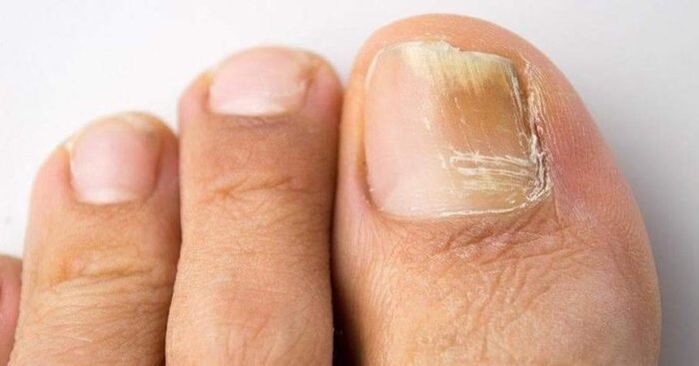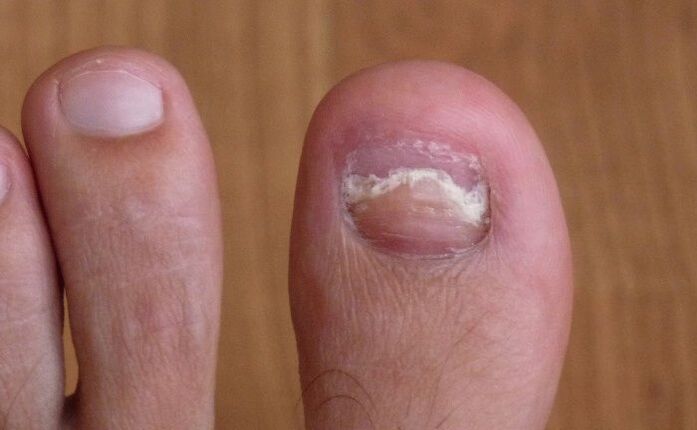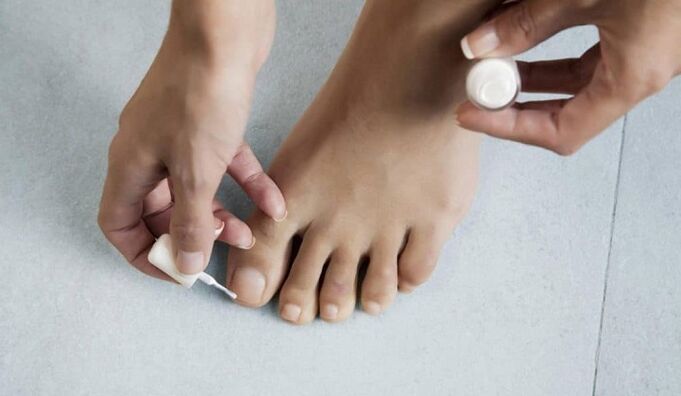Fungal infections can affect various tissues and even internal organs. If the disease affects the nail, it is called onychomycosis. The appearance is caused by fungal microorganisms.
They are divided into different genera: candidiasis, mold fungi, dermatophytes. Parasites literally feed on the nail plate, which leads to its early destruction. Mycosis itself does not pass. This is possible only when the symptoms are not visible, with the strongest work of the immune system and the first stage of the disease. If you show signs of illness, you can be sure that they will not go anywhere without therapy.

Appearance reasons
Fungal microorganisms belong to the class of irritants. They are extremely determined. They quickly penetrate the tissues and adapt to different conditions. This is due to the complexity of the treatment of the disease. If you use the same drug for a long time, parasites can stop reacting to it.
The only cause of the disease is the entry of fungus into the nail plate. However, there are factors that favor its early application and subsequent reproduction. If corn is corn, it is more likely to penetrate the tissues. Dry skin can also cause micro-cracks that the fungus can easily penetrate. The microorganism "loves" wet conditions and is therefore actively spread in people who prefer tight shoes made of weak materials that do not allow air to pass through.
Nail fungus on the thumb often occurs against the background of various pathologies:
- Endocrine diseases;
- Psoriasis;
- Varicose veins;
- Vascular diseases;
- HIV and AIDS;
- Problems with metabolic processes;
- Eczema;
- Dermatitis;
- Skin infections.
Fungal microorganisms can enter the board in the following ways:
- Contact with an infection carrier;
- To visit public baths, saunas, showers;
- Wearing someone else's slippers (for example, at a party);
- Living with a person with mycosis;
- Try on shoes;
- Use of non-disinfected pedicures;
- Visit beauty salons.
The factors that provoke the appearance of mycosis are:
- Lack of adequate personal hygiene;
- Preference for synthetic items;
- Wear tight shoes that do not allow the skin to "breathe";
- Excessive obesity;
- Frequent alcohol consumption;
- Old age.
If a person has a circulatory disorder in the leg area, the disease will have more striking manifestations. In addition, a change in the acid balance observed while taking antibiotics can lead to pathological processes.
Stages of the disease
The surface under the nails is very favorable for the growth of fungal microorganisms. Contains many nutrients that parasites feed on. Gradually, due to the action of bacteria, the destruction of the nail plate occurs. Gaps begin to form where the mycelium proliferates. There are the following stages of the disease:
- Initial.Refers to the type of normotrophic damage. The main damage affects the middle or edge of the tile. Gradually growing spots and streaks appear;
- Medium.Represents hypertrophic changes. This stage is characterized by thickening of the nail, changes in its structure, the direction of growth. Pathological processes gradually spread along the plate;
- Stage of dystrophy.Inflammation of the nail layer is added to the listed processes. Pus discharge is possible. The damage reaches the nearby skin. Additional bacterial infections accelerate the destruction of the nail. It begins to collapse, tearing from the nail bed.
At first, the symptoms are insignificant, and therefore people often take the disease lightly. But it is moving fast. Soon the spots will start to grow. The disease can be transmitted from the thumb to others.
If only a small image is affected, it is usually mild to moderate. Therapy should be performed immediately.

Symptoms
Symptoms vary greatly depending on the stage of the disease. At first it is almost impossible to see a sign of threat. The following symptoms can be observed with the development of the disease:
- Mild itching;
- Redness on the thumb;
- Burning sensation.
But the pathological process does not stop there. Its growth can be assessed by the following features:
- Fragile plate, loss of natural luster;
- Obtain a yellow, blue or green color (depending on the type of fungal microorganisms that affect the nail);
- Removed spots and streaks are visible;
- The nail grows in a roll with corners, which is evidence of deformation of the growth.
The following symptoms are possible in the advanced stages:
- Walking pain syndrome;
- Appearance of swelling of the finger, significant redness;
- Discharge of pus from the bottom of the edges.
Symptoms of large nail fungus can vary depending on the type of fungus that is causing the infection. For example, if these are moldy fungi, the disease will be very obvious. The nail can literally turn black. There is swelling, the appearance of silver scales, yellow edges. The plate begins to move away from the bed, which is a serious concern. However, in 95% of cases, the cause of infection is dermatophytes. They are characterized by a relatively moderate course of the disease.
The disease affects not only the nails, but the whole body. This is because toxins enter the lymphatic ducts. This leads to the following changes:
- Allergic reactions, appearance of skin rashes;
- Gastrointestinal problems;
- Symptoms of intoxication.
If nothing is done with the advanced stage of mycosis, the lesion can spread to the internal organs. This is extremely dangerous.
How is the treatment performed?
How to treat nail fungus? Pathogenic microorganisms are distinguished by a jealous resistance to various influences. They take root rapidly inside and begin to actively reproduce. Therefore, it is desirable to conduct a full-fledged antifungal therapy. These include:
- Use of local funds. May be ointments, drops, medicated varnishes, solutions. These are required to defeat the disease at the superficial level. Local medicines include varnish, serum;
- Systemic drugs. Used for significant lesions of the nail plate. Tablets are used daily. Pulse therapy is effective. It consists of taking short-term medications with a long break. Then the course is repeated. It should be noted that the pills can not be taken in all cases. Do not use them in the early stages of the disease. These funds are very strong and therefore have contraindications: pregnancy, childhood, kidney failure, intolerance to the components.
The disease is often accompanied by bacterial complications. You can be safe from them too. Antifungal varnish is ideal for this purpose. Creates a film on the surface of the plate that bacteria do not penetrate.
In addition, the body's immune system needs to be stimulated to fight infection. Vitamin complexes and immunomodulatory drugs are used for this purpose.
Most drugs have a cumulative effect. It is not enough to take them once and forget about therapy. A full course is required.
Even if all the symptoms disappear, it does not end. The active ingredients accumulate in the mixture and continue to function even after taking the drug.
Another additional procedure is the removal of nails. It is relevant for severe pathological processes. Extraction can be used products containing special urea. If the tile is hard, it will take several procedures to remove it completely. There is no need to be afraid of being removed because it is painless. After removal, the surface should be treated with antiseptics. Removal is convenient because local medications can then be applied directly to the nail bed. This significantly increases their efficiency.

Traditional methods
Folk remedies can not replace drugs. But they are suitable for additional help. The following components help the fungus:
- Iodine.The affected area should be lubricated with iodine twice a day. If there is a burning sensation, you should eliminate all the excess and reduce the dose;
- Lemon.A slice of lemon is applied to the affected area, then fixed with a bandage. Cellophane is placed on top;
- Hydrogen peroxide.A cotton pad is moistened with hydrogen peroxide, then fixed on the nail for 30 minutes. Softened areas can be removed.
After all these procedures, treatment with topical antimicrobials is desirable.
Preventive measures
It is important to follow preventive measures only for a person who does not want to be infected with mycosis. These are the basis for people who have just recovered from the disease. Prevention consists of the following rules:
- Compliance with personal hygiene;
- Daily foot bath;
- Lubricate the feet with moisturizers, pedicure;
- Use of personal slippers;
- Treatment of nails with prophylactic substances before visiting the baths and showers. You can replace the special product with lemon juice.
Prevention measures are more stringent for people who have recently had mycosis:
- To use a local remedy for fungus once a week;
- Regular use of hot foot baths with the addition of sea salt;
- Treatment of shoes with antifungal compounds;
- Hot socks that are completely destroyed by microorganisms;
- You should continue to take vitamins;
- The surface of the bath is disinfected. It is advisable to treat all other surfaces in the house.
Prevention with a high probability protects against mycosis. You just have to watch the condition of your feet. If unexplained symptoms reappear, you should see a doctor immediately. Self-medication is not recommended because mycosis is easily confused with other problems. In this case, the wrong treatment will be chosen and the disease will continue to progress. All this is fraught with great problems in the future. Acceptance of systemic funds is carried out under the supervision of a physician.

























